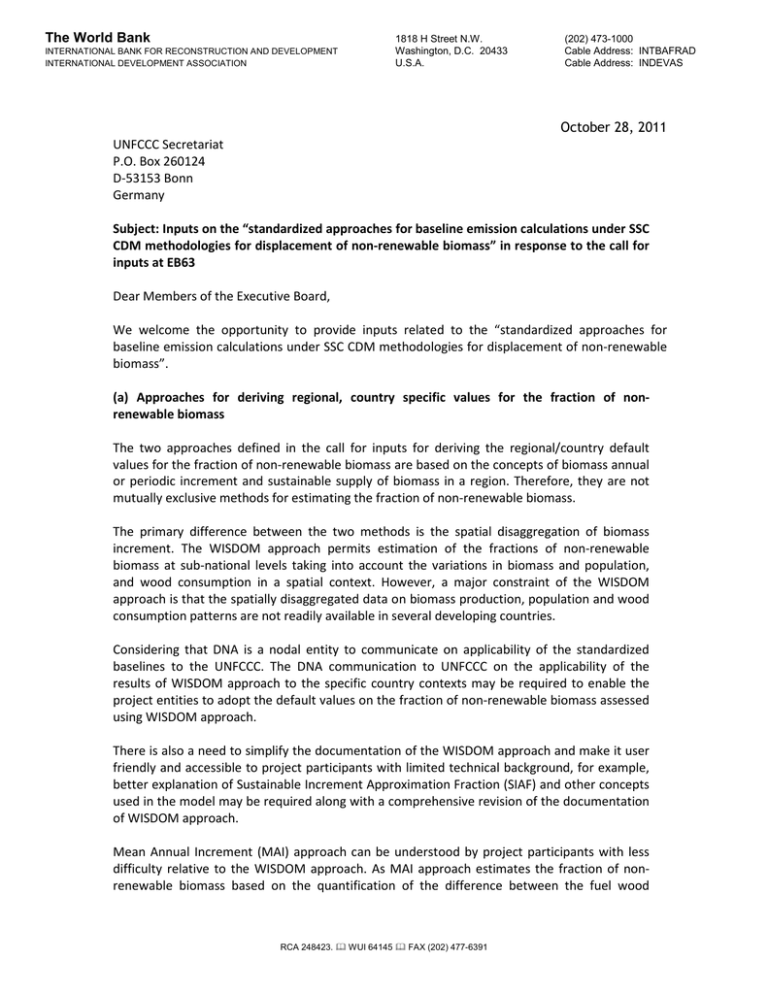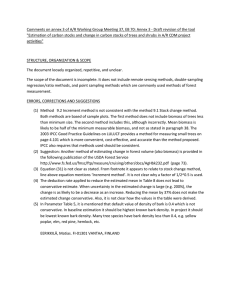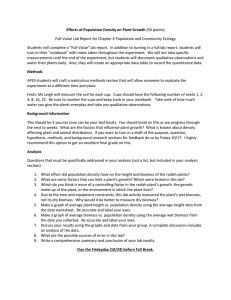The World Bank
advertisement

The World Bank INTERNATIONAL BANK FOR RECONSTRUCTION AND DEVELOPMENT INTERNATIONAL DEVELOPMENT ASSOCIATION 1818 H Street N.W. Washington, D.C. 20433 U.S.A. (202) 473-1000 Cable Address: INTBAFRAD Cable Address: INDEVAS October 28, 2011 UNFCCC Secretariat P.O. Box 260124 D-53153 Bonn Germany Subject: Inputs on the “standardized approaches for baseline emission calculations under SSC CDM methodologies for displacement of non-renewable biomass” in response to the call for inputs at EB63 Dear Members of the Executive Board, We welcome the opportunity to provide inputs related to the “standardized approaches for baseline emission calculations under SSC CDM methodologies for displacement of non-renewable biomass”. (a) Approaches for deriving regional, country specific values for the fraction of nonrenewable biomass The two approaches defined in the call for inputs for deriving the regional/country default values for the fraction of non-renewable biomass are based on the concepts of biomass annual or periodic increment and sustainable supply of biomass in a region. Therefore, they are not mutually exclusive methods for estimating the fraction of non-renewable biomass. The primary difference between the two methods is the spatial disaggregation of biomass increment. The WISDOM approach permits estimation of the fractions of non-renewable biomass at sub-national levels taking into account the variations in biomass and population, and wood consumption in a spatial context. However, a major constraint of the WISDOM approach is that the spatially disaggregated data on biomass production, population and wood consumption patterns are not readily available in several developing countries. Considering that DNA is a nodal entity to communicate on applicability of the standardized baselines to the UNFCCC. The DNA communication to UNFCCC on the applicability of the results of WISDOM approach to the specific country contexts may be required to enable the project entities to adopt the default values on the fraction of non-renewable biomass assessed using WISDOM approach. There is also a need to simplify the documentation of the WISDOM approach and make it user friendly and accessible to project participants with limited technical background, for example, better explanation of Sustainable Increment Approximation Fraction (SIAF) and other concepts used in the model may be required along with a comprehensive revision of the documentation of WISDOM approach. Mean Annual Increment (MAI) approach can be understood by project participants with less difficulty relative to the WISDOM approach. As MAI approach estimates the fraction of nonrenewable biomass based on the quantification of the difference between the fuel wood RCA 248423. & WUI 64145 & FAX (202) 477-6391 -2October 28, 2011 consumption and the adjusted mean annual increment of biomass growth, the forest inventory studies available at a sub-national or a country or region levels and relevant forestry expertise could accessed by DNAs and project participants. In adopting MAI approach at sub-national or national or regional levels, regional variations in the MAI of forests could be captured in MAI calculation weighted by the forest type/vegetation in sub-national or national or regional contexts. Therefore, both WISDOM and MAI approaches could be permitted for assessing the default values for the fraction of non-renewable biomass and that the project participants can choose either of the two approaches for estimating the fraction of non-renewable biomass. (i) Practicality and appropriateness of the defined approaches Project participants may be allowed to choose either of the two approaches. Where possible, countries should be encouraged to derive sub-national non-renewable biomass fractions using either approach. (ii) Frequency of update of the values for fraction of non-renewable biomass Forestry inventory statistics are important inputs in both approaches. In most developing countries, forest inventory and assessment happens at irregular intervals. Countries that conduct regular forest inventory and assessment normally do so with a periodicity of 5 to 10 years. The Forest Resource Assessment of FAO (FRA) is the most comprehensive inventory on the state of forest cover and growth and could be used for this purpose. The frequency for update of the values of the fraction of the non-renewable biomass could therefore be set to coincide with the periodicity of FAO forest resource assessment. The fraction of non-renewable biomass could be included as an item for monitoring and reporting under the FAO forest resource assessment. This will ensure the estimates of the fraction of non-renewable biomass assessed in FAO forest resource assessment could serve as the default values. (iii) Level of aggregation that can reliably represent the non-renewability of displaced biomass Countries should strive for a sub-national (i.e. administrative boundaries of states or provinces or agro-ecological zones) level of aggregation although countries with low capacity should be allowed to start with national level data. (iv) Other approaches for determining fNRB Until the FAO Forest Resource assessment operationalizes the reporting on the fraction of nonrenewable biomass, the data and information available in the published research studies may be permitted so as to facilitate the availability of the data on non-renewable biomass fraction at sub-national level. (b) Default parameters for baseline fuelwood consumption per capita or per household (i) Level of aggregation of default wood fuel consumption The wood fuel consumption reported at a regional level noted in Table 1, Annex 8 of 33rd meeting report of the SSC Working Group could be adopted as a default. The forest resource assessment of FAO could collate fuelwood consumption at regional, national and sub-national -3October 28, 2011 levels, which could be used as default fuelwood consumption for projects and programs under CDM. In situations where fuelwood consumption is reported at sub-national (i.e., administrative boundaries of states or provinces or agro-ecological zones) level, it could be permitted as it reflects the consumption pertinent to the sub national/local levels. For example, The World Bank Living Standard Measurement Surveys (LSMS) and national socioeconomic surveys report household fuelwood consumption at sub-national/local levels. (ii) Frequency of update of the default values It would be useful to have similar frequency of update of the default fuelwood consumption values as that of the FAO forest inventory and assessment and reporting. In this context, the 5 to 10 year updates of wood fuel consumption published by FAO/IEA or other relevant organization could be adopted. We will be glad to provide any further information and clarifications as necessary. With kind regards, Rama Chandra Reddy Acting Team Leader, Policy and Methodology Carbon Finance Unit, World Bank






